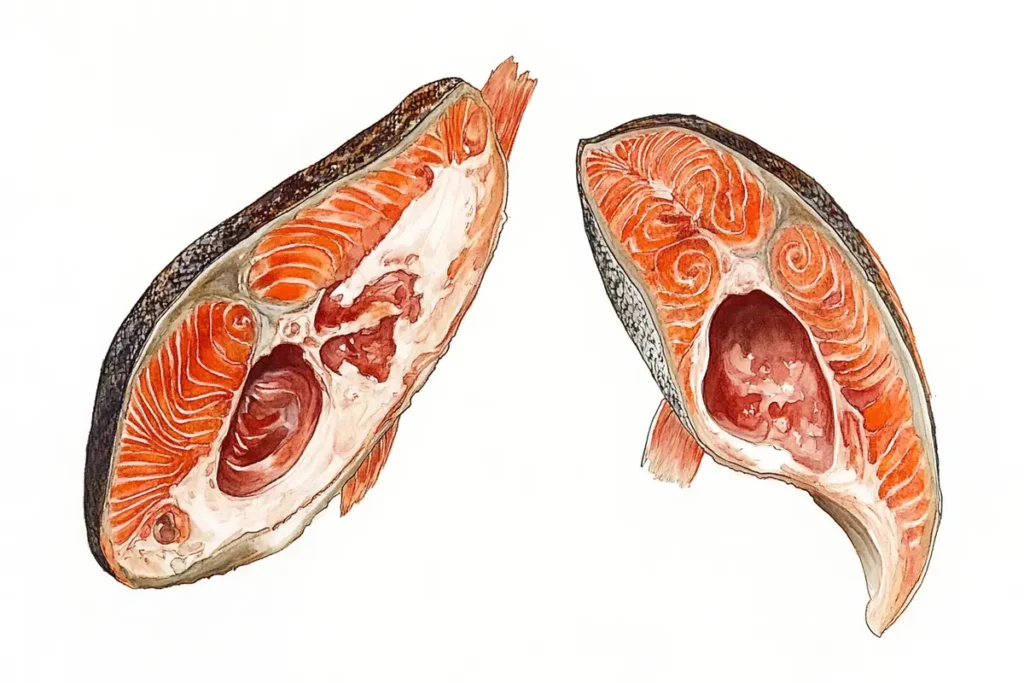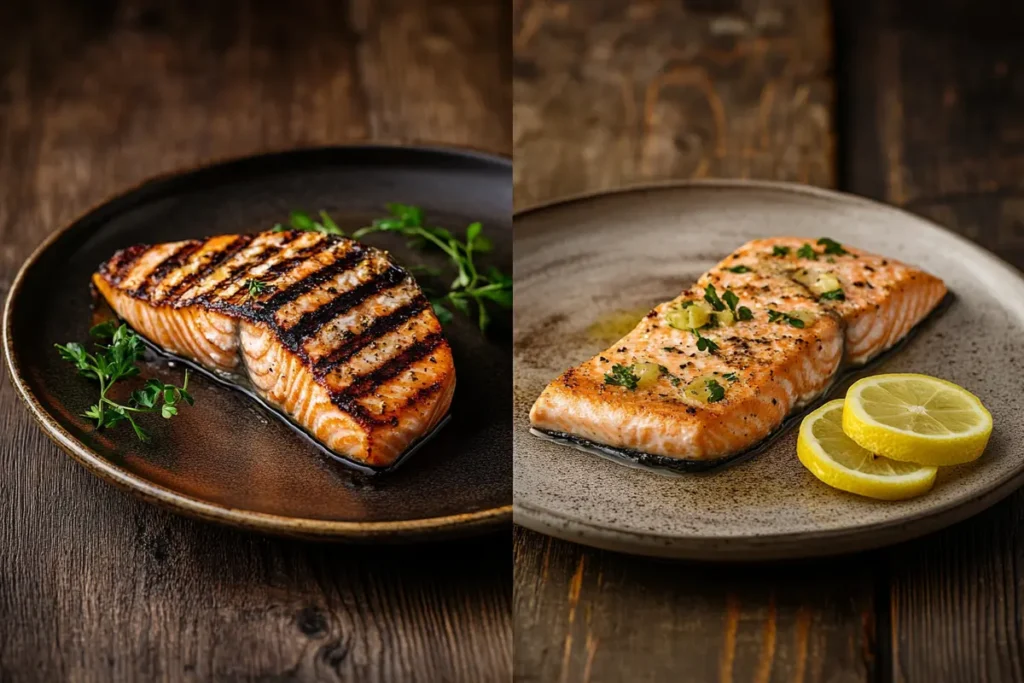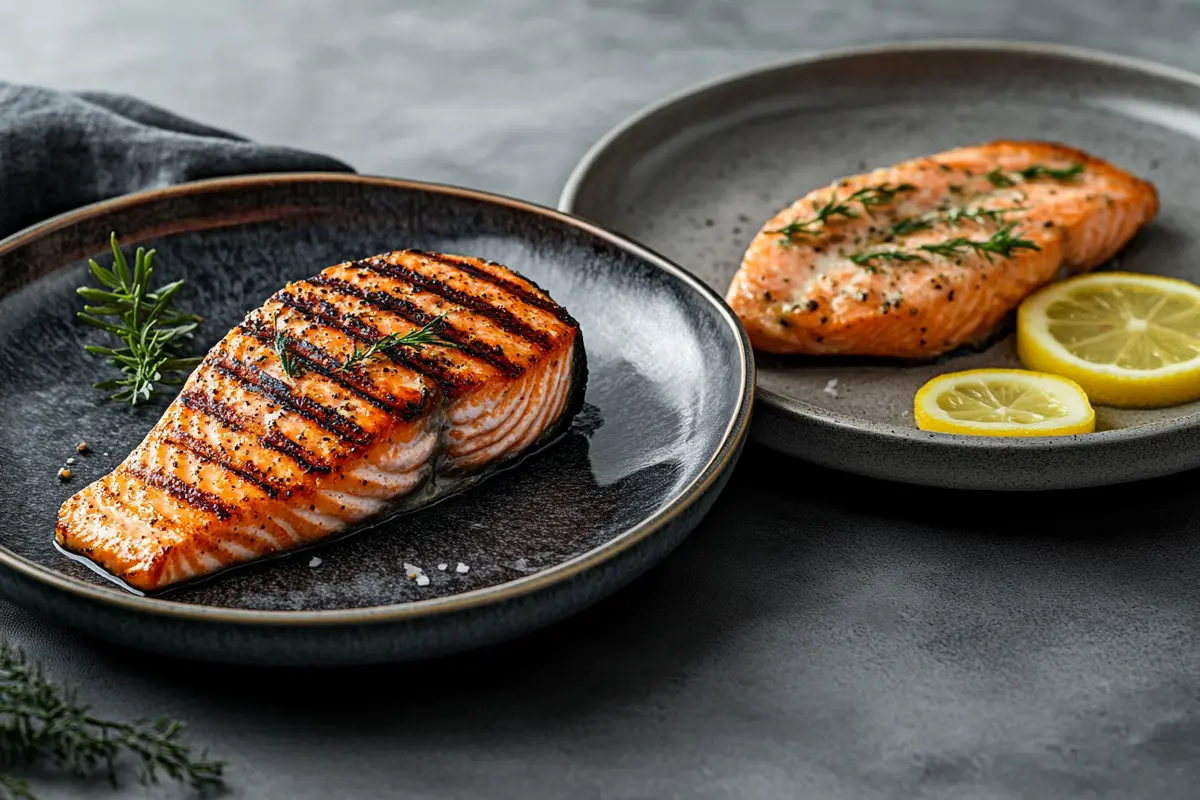Ever found yourself standing in front of the seafood counter, scratching your head and wondering, “What is the real difference between a salmon steak and a salmon fillet?” You’re definitely not alone! It’s a common question, and quite frankly, a fair one. Both cuts of salmon are delicious and nutritious, but they’re also quite distinct. This article will dive deep into the world of salmon, exploring the nuances between these two popular choices. We’ll unravel their differences, from their physical form and cut of the salmon fish to their cooking applications, nutritional profiles, and how to best choose the right one for your next culinary adventure. So, get ready to clear up the confusion: Is salmon steak the same as salmon fillet? By the end, you’ll be a salmon expert, ready to confidently navigate any seafood menu or market.
Introduction: Unpacking the Salmon Confusion
Setting the Stage: The Popularity of Salmon
Salmon, oh salmon! It’s no secret that this fish has become a superstar on dinner plates across the globe. It’s celebrated for its rich flavor, vibrant color, and impressive nutritional benefits, including omega-3 fatty acids. From fancy restaurants to cozy home kitchens, salmon reigns supreme. But with its widespread popularity comes an abundance of choices, which can sometimes lead to a bit of bewilderment, especially when it comes to different cuts.
The Question at Hand: Is Salmon Steak the Same as Salmon Fillet?
Here’s the million-dollar question: Is salmon steak the same as salmon fillet? The answer, in short, is no. Though both come from the same marvelous fish, they are very different cuts, each with its own characteristics. These differences ultimately affect the way they cook, taste, and even how they’re best presented.
Brief Overview of Salmon Cuts: A Culinary Teaser
Think of it this way: a salmon steak is like a cross-section of the whole fish, often including a bone. On the other hand, a salmon fillet is a boneless portion cut lengthwise along the side of the fish. We’ll delve into the anatomy, shape, and where exactly each cut comes from, so stay tuned.
Why the Confusion Exists: Common Misconceptions
The confusion often arises because both terms refer to salmon, a fish that is often the star of many meals. Also, people often think all cuts of salmon are the same, a simple mistake. However, the differences are key to making the best choices for your needs. So, let’s break things down and clear up all the salmon related confusion for good!
Defining the Salmon Steak
What Exactly is a Salmon Steak?
Okay, so what exactly is a salmon steak? Well, picture this: it’s a cross-section cut of the whole salmon, kind of like a slice from a loaf of bread. This means it’s a thicker cut, and most importantly, it often includes a portion of the backbone, along with the skin. So, unlike a fillet, which is boneless, a steak usually has a bone in it. This simple difference changes everything, from how it cooks to how it tastes.
Anatomy of a Salmon Steak: Identifying Key Features

The Bone-in Aspect of Salmon Steak
The most noticeable characteristic of a salmon steak is, without a doubt, the bone. This bone isn’t just some random element; it actually adds flavor and helps keep the steak moist during cooking. It’s central to the cut, a key feature that separates it from fillets.
Understanding the Thickness of the Salmon Steak
Furthermore, salmon steaks are generally thicker than fillets. This added thickness means they take a bit longer to cook through, and it makes them ideal for methods like grilling or pan-searing, where a nice crust can be achieved without overcooking the inside.
The Cut of the Salmon Fish: Cross-section
As we said, the salmon steak comes from a crosswise cut across the entire fish. This cut includes the bone and surrounding flesh, making it a hearty and substantial portion. This method of cutting is crucial to understand Is salmon steak the same as salmon fillet?
Grilling Techniques for Salmon Steak
Due to their thickness and bone-in structure, salmon steaks are fantastic for grilling. The heat from the grill helps to crisp the skin and imparts a smoky flavor. The bone also helps to keep the meat moist.
Pan-Seared Salmon Steak: Tips for Success
Alternatively, pan-searing is another great option for salmon steaks. Using a hot pan with a bit of oil, you can get a wonderfully crispy skin, while the inside remains tender and juicy. It’s all about achieving that perfect balance.
Defining the Salmon Fillet
What Exactly is a Salmon Fillet?
Now, let’s turn our attention to the salmon fillet. In contrast to a steak, a fillet is a boneless portion of the salmon that is cut lengthwise along the side of the fish. Think of it as a long, flat piece of meat, usually with the skin still attached. Therefore, the absence of bones is a major distinction when comparing salmon steak and salmon fillet.
Anatomy of a Salmon Fillet: Identifying Key Features
Understanding the Boneless Nature of Salmon Fillet
The defining characteristic of a salmon fillet is its boneless nature. This makes it very easy to cook and eat, which is why it’s often a favorite choice. The lack of bones also means there’s no risk of having to pick around them while enjoying your meal.
Analyzing the Shape and Size of a Salmon Fillet
Fillets are typically more uniform in shape and size compared to steaks. They are generally flat and elongated, which allows for even cooking. This consistency makes them a very versatile choice in the kitchen.
The Cut of the Salmon Fish: Along the Side
The salmon fillet comes from the side of the fish, removed whole from the backbone. This method of cutting results in a large, boneless portion of salmon. It’s different from a salmon steak, and knowing this is essential for understanding the key differences.
Baking Salmon Fillet: Methods and Recipes
Salmon fillets are excellent for baking. Their even thickness allows them to cook through evenly in the oven. Furthermore, baking is a very healthy cooking method, which makes salmon fillets a popular choice.
Sautéing Salmon Fillet: A Quick and Easy Option
Sautéing salmon fillets is another quick and easy option. The fillet’s even thickness makes it ideal for sautéing, as it cooks very quickly and evenly. This method works well for those with a time crunch and still wanting to prepare a tasty meal.
Remember, these differences in cuts of salmon are vital in understanding whether Is salmon steak the same as salmon fillet? It is definitely not the same! Each has its own place in the culinary world.
Salmon Steak vs Salmon Fillet: The Key Differences
Bone Structure: The Presence and Absence
Perhaps the most glaring distinction between a salmon steak and a salmon fillet is the presence or absence of bone. As we’ve covered, salmon steaks are typically bone-in, which can be a real flavor enhancer. However, this means that you might have to navigate around the bone while eating. Conversely, salmon fillets are always boneless, offering a convenient and hassle-free experience. This single difference greatly affects the cooking method and eating experience.
Thickness and Shape Comparison of Salmon Cuts
Another key difference lies in their thickness and shape. Salmon steaks, due to their cross-sectional cut, tend to be thicker and more irregular in shape, which also impacts their cooking. Fillets, in contrast, are usually thinner and have a more uniform shape, making them suitable for a variety of cooking methods. These distinctions underscore the fact that is salmon steak the same as salmon fillet? Absolutely not!
Cooking Methods: Which Cut is Better Suited?

Salmon Steak for High-Heat Cooking
Salmon steaks really shine when subjected to high-heat cooking methods, such as grilling or pan-searing. The bone-in structure helps to keep the fish moist and flavorful, and the thickness allows for a beautiful sear on the outside. This cooking technique is ideal for salmon steaks.
Salmon Fillet for Delicate Recipes
On the other hand, salmon fillets, thanks to their even thickness, are often better suited for more delicate cooking methods, such as baking or sautéing. Fillets tend to cook quickly and evenly, making them perfect for recipes that require a gentler touch.
The Impact of Bone-In Cooking on Flavor of Salmon Steak
The bone in a salmon steak imparts a unique flavor as it cooks, adding depth and richness to the fish. Also, the collagen from the bones can add a silkiness to the texture. This adds an edge to the flavor profile of a salmon steak.
Texture Comparison: Delicate vs. Firm Salmon
Fillets usually have a more delicate and flaky texture, especially when gently cooked, while steaks may have a slightly firmer texture because of the surrounding tissue and the bone-in aspect. The choice between the two really depends on your preference.
Presentation Differences: How They Look on a Plate
Finally, the presentation of salmon steak versus salmon fillet is also different. Steaks often have a more rustic and robust appearance, while fillets have a cleaner, more elegant look. Ultimately, your choice may come down to the aesthetic you’re aiming for.
Nutritional Differences Between Salmon Steak and Salmon Fillet
Omega-3 Fatty Acids: Are They the Same?
Understanding the Omega-3 Content in Both Cuts
When it comes to nutritional value, both salmon steaks and fillets are excellent sources of omega-3 fatty acids. The content is actually very similar in both cuts. Therefore, you can get your omega-3s from either choice.
Protein Content: A Comparative Analysis
Similarly, the protein content of salmon steaks and fillets is also comparable. Both provide a rich source of protein, essential for muscle building and overall health.
Calorie Count and Fat Content: A Detailed Overview
The calorie count and fat content in both cuts are also quite similar, with only minor variations. The differences are often negligible, meaning your choice can be made independent of these aspects.
Vitamin and Mineral Profiles: What Are the Differences?
Furthermore, both salmon steaks and fillets boast an impressive array of vitamins and minerals, including Vitamin D, Vitamin B12, and potassium. There may be slight differences, but these are generally too small to be a deciding factor.
Which is the Healthier Choice: Salmon Steak or Salmon Fillet?
Ultimately, when we examine all these nutritional aspects, neither salmon steak nor salmon fillet is significantly “healthier” than the other. Both offer a wealth of beneficial nutrients, making them both excellent choices for a balanced diet. Thus, it’s really a matter of your personal preference, culinary needs, and desired cooking method.
Choosing the Right Cut of Salmon for Your Recipe
Factors to Consider When Selecting Salmon
Cooking Method and its impact on your Choice
When deciding between a salmon steak and a salmon fillet, it’s crucial to think about your cooking method. If you’re planning to grill or pan-sear, a salmon steak might be the better option due to its thickness and bone-in structure, which helps it retain moisture. Conversely, for baking or sautéing, a salmon fillet’s even shape is more suitable. The method matters when considering is salmon steak the same as salmon fillet? No, because they do not work in the same recipes.
Personal Preference and Desired Texture
Your personal preference and desired texture also play a big role. If you love a robust, slightly firmer texture, a steak might be your go-to. However, if you prefer a more delicate, flaky texture, then a fillet is probably the best choice.
When to Use Salmon Steak: Ideal Scenarios
Salmon steaks are ideal for situations where you want to achieve a smoky, flavorful, and substantial meal. Think of summer barbecues, or hearty, home-cooked dinners where a robust flavor profile is appreciated. They also excel when cooking at high temperatures, since the bone provides insulation.
When to Use Salmon Fillet: Ideal Scenarios
Salmon fillets are fantastic for quick and easy weeknight meals, where you want a lighter, more delicate dish. Their versatility makes them perfect for various cooking methods. They can be baked, sautéed, or even poached, providing an easy cooking experience.
Salmon Steak or Salmon Fillet: Which Should You Choose?
In the end, the decision really boils down to personal preference and what you intend to cook. Both cuts of salmon have their own unique qualities, and understanding these differences will ensure you make the best choice for every meal. It really is about understanding what you want to achieve with your dish.
Buying and Storing Salmon Steaks and Fillets
How to Select Fresh Salmon: Key Indicators
When purchasing either salmon steaks or fillets, freshness is key. Look for salmon that has a vibrant color, a firm texture, and a fresh, ocean-like smell, rather than a fishy odor. Make sure the flesh looks moist and not dried out. These factors are important to understand before buying.
Understanding the Difference Between Farmed and Wild Salmon
Furthermore, consider whether you prefer farmed or wild-caught salmon. Wild salmon often has a richer flavor and tends to be leaner, while farmed salmon is usually more affordable and readily available. Both offer good nutrients, but their flavor and texture may differ.
Proper Storage Techniques for Salmon Steak and Fillet
Refrigeration and Freezing Guidelines for Salmon
Once you get your salmon home, it’s important to store it properly. Keep both salmon steaks and fillets in the coldest part of your refrigerator and use them within one to two days. If you are not going to use them within that time, you should freeze them right away.
Shelf Life of Salmon Cuts: What to Expect?
Frozen salmon can last for several months in the freezer, while fresh salmon should be used within one to two days of purchase. Always ensure it’s properly wrapped to prevent freezer burn. These storage tips are vital to maintain quality and safety. Thus, both salmon steak and fillets should be stored properly.
FAQs: Answering Common Questions About Salmon Cuts
Q: What is the main difference between salmon steak and salmon fillet?
The main difference lies in the cut of the salmon and the presence of a bone. A salmon steak is a cross-section cut that usually contains a bone, while a salmon fillet is a boneless portion taken from the side of the fish.
Q: Is one cut of salmon healthier than the other?
Nutritionally, both salmon steak and salmon fillet are very similar. Both are rich in omega-3 fatty acids, protein, and other essential vitamins and minerals. Thus, neither is inherently healthier than the other.
Q: Can I use salmon steak and salmon fillet interchangeably in recipes?
While you can substitute one for the other, the results may vary. Salmon steaks are better suited for high-heat cooking like grilling, while fillets are ideal for gentler methods like baking. Therefore, it’s best to choose according to the intended cooking method.
Q: How do I cook salmon steak perfectly?
For a perfectly cooked salmon steak, use a hot grill or pan and cook it skin-side down first until the skin is crispy. It’s then key to make sure it is cooked through but not overcooked to keep it tender. Check the internal temperature to ensure doneness. These tips should help you master the art of cooking salmon.
Conclusion: Salmon Steak and Fillet – Both Great Options
Recap of the Key Differences Between Salmon Cuts
Alright, let’s recap. We’ve explored the key differences between a salmon steak and a salmon fillet. A steak is a cross-section cut, often with a bone, and generally thicker. On the other hand, a fillet is a boneless cut taken from the side of the fish, and it is typically thinner. These differences impact their cooking methods, texture, and even flavor.
Final Thoughts on Is Salmon Steak the Same as Salmon Fillet
So, is salmon steak the same as salmon fillet? Absolutely not! They are different cuts, with unique characteristics. Both are fantastic choices, but knowing their differences helps you select the right one for your culinary needs. These distinctions are important for your culinary endeavors.
Encouraging Readers to Explore Both Salmon Options
Ultimately, both salmon steaks and fillets offer a wealth of nutrients and flavor, and both should be part of a balanced diet. So, we encourage you to try both and see which one best suits your tastes. There’s no right or wrong choice, just what you prefer most in a salmon meal.

